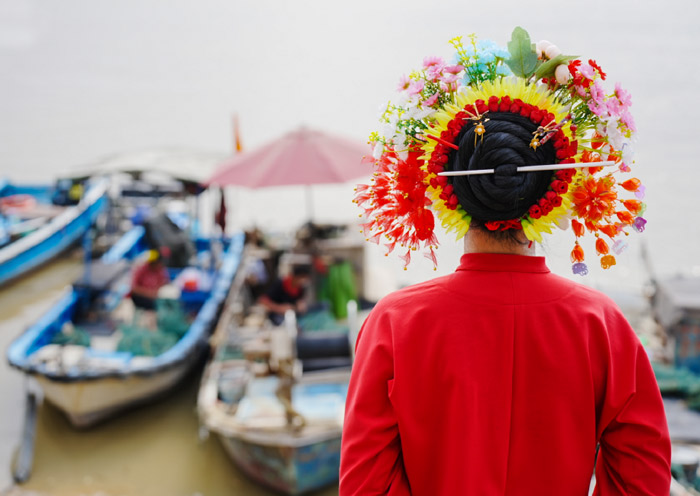Top Attractions of Religions in Quanzhou
Quanzhou is known as the "World Museum of Religions". Thanks to Quanzhou's thriving maritime trade, the city has historically been a melting pot of various cultures and religions. Over centuries, multiple religions including Buddhism, Taoism, Islam, Christianity, and others have coexisted and flourished in Quanzhou, leaving behind a wealth of religious architecture, artifacts, and cultural traditions.
Among the 22 World Heritage Sites in Quanzhou, 8 are related to religion. The following 7 attractions except Guanyue Temple are all on the World Heritage List.
No.1 Kaiyuan Temple
- Chinese Name: 开元寺(kai yuan si)
- Religion: Buddhism
- History: Over 1330 years old
- Opening Time: 6:30 - 17:40
- Recommend Visiting Time: 1 - 1.5 hours
- Highlights: The East and West Pagodas, the Main Shrine Hall, traces of Hinduism
Kaiyuan temple was initially built in 686 during the Tang Dynasty, and its name "Kaiyuan," which translates to "opening fortune," was given by Emperor Zhongzong of Tang (唐中宗) in the year 738. Over the years, it has undergone numerous restorations and expansions and now it is the largest Buddhist temple in Fujian.
The East and West Pagodas, standing over 40 meters high, are considered the landmarks of Quanzhou and are among the oldest and tallest stone pagodas in China. The East Pagoda is known as Zhenguo Pagoda (镇国塔) and the West Pagoda is known as Renshou Pagoda (仁寿塔). Both are intricately carved and have been well preserved.
Inside Kaiyuan Temple, you can also find traces of Hinduism, such as stone pillars carved with Indian mythological stories, and relief bases carved with the shape of the Sphinx.
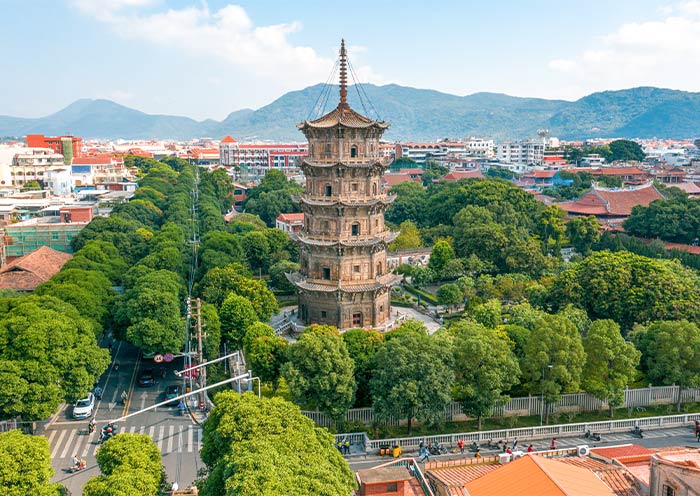
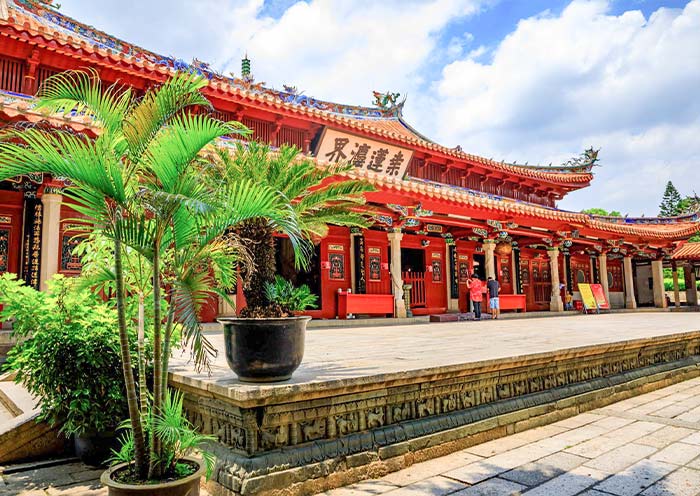
No.2 Qingjing Mosque
- Chinese Name: 清净寺(qing jing si)
- Religion: Islam
- History: Over 1000 years old
- Opening Time: 9:00 - 17:15
- Recommend Visiting Time: 0.5 - 1 hour
- Highlights: Both Arabic and Chinese architectural styles
The Qingjing Mosque, also known as the Ashab Mosque, is a famous historic mosque located in Quanzhou, Fujian, China. It's one of the oldest mosques in China.
The mosque was originally built in 1009 during the Song Dynasty by the Arab Muslim community in Quanzhou. The name 'Qingjing' translates to 'Pure and Clean', symbolizing the pure and peaceful spirit of Islam.
A particularly interesting feature of the Qingjing Mosque is that it incorporates both Arabic and Chinese architectural styles. The main prayer hall resembles Middle Eastern mosques, while elements such as the pagoda-style minaret showcase traditional Chinese craftsmanship. As a symbol of the ancient Maritime Silk Road's cultural exchange, it stands as a testament to Quanzhou's multicultural past.
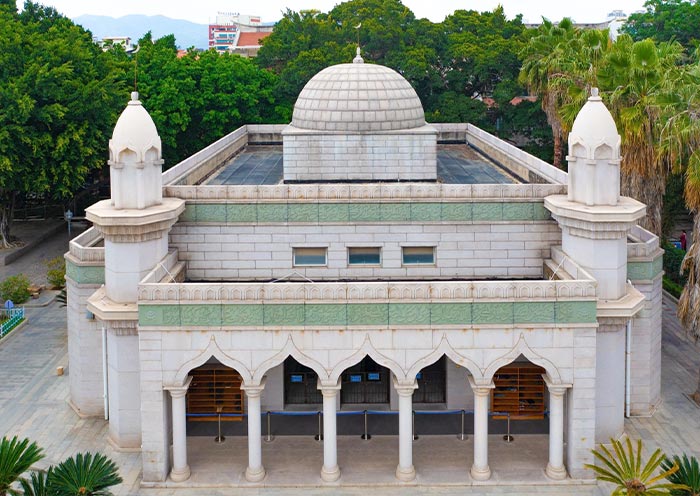
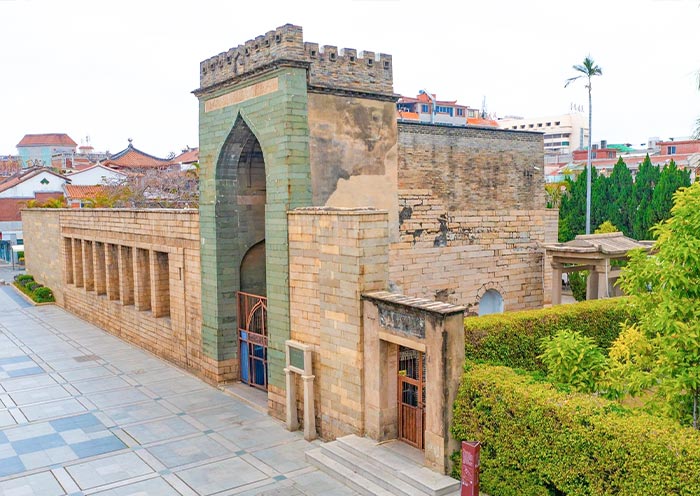
No.3 Guanyue Temple
- Chinese Name: 通淮关岳庙 (tong huai guan yue miao)
- Religion: Buddhism
- History: Over 400 years old
- Opening Time: 6:00 - 18:00
- Recommend Visiting Time: 1 hour
- Highlights: Minnan architecture with beautifully decorated carvings, efficacious divination through drawing lots
The Tonghuai Guanyue Temple is located on Tumen Street in Quanzhou City. It was first established in the early Qing Dynasty, mainly worshiping Guan Yu. In the year 1914, Yue Fei was added to the worship, hence the current name “Guan Yue”.
The Guanyue Temple is known for its efficacious divination through drawing lots, so it is always full of incense. Upon entering the Guanyue Temple, you will find it filled with swirling smoke and a strong scent of Zen incense.
The architectural style of the Guanyue Temple reflects the artistic style of ancient Minnan architecture, with beautifully decorated wood carvings, stone carvings, and clay sculptures. The ridge of the roof features treasure pagodas and dragon heads, interspersed with birds and beasts. The beautiful architecture makes it worth photographing and admiring. Moreover, visiting the Guandi Temple at night reveals its shimmering golden light, befitting a temple with a thriving incense for seeking wealth.
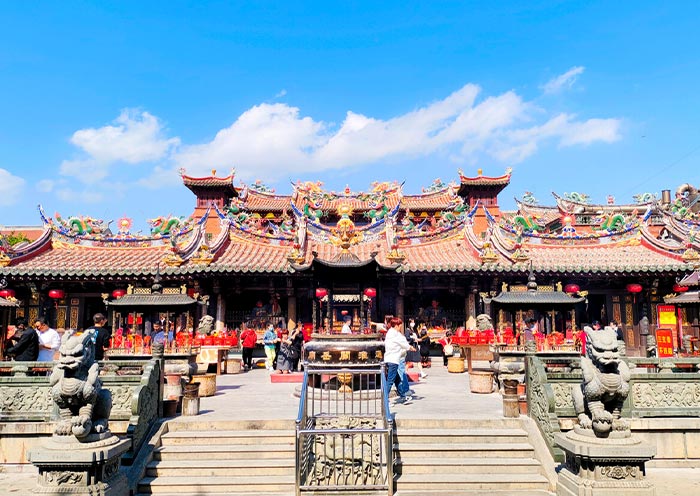
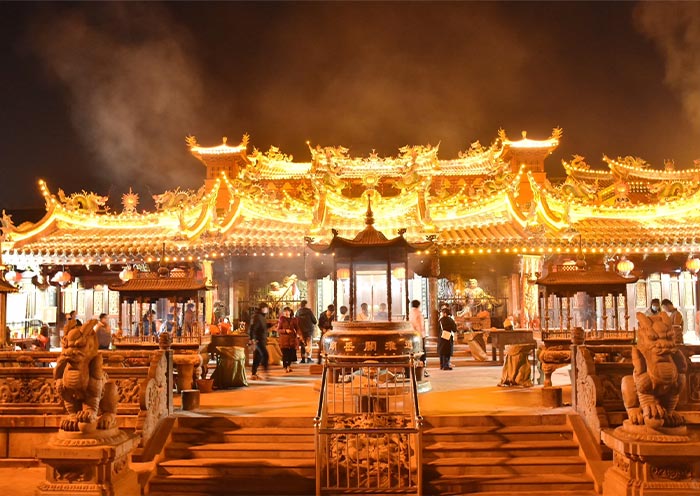
No.4 Thean Hou Temple
- Chinese Name: 天后宫 (tian hou gong)
- Religion: Mazhu (妈祖)
- History: Over 800 years old
- Opening Time: 7:00-18:00
- Recommend Visiting Time: 1 hour
- Highlights: Main hall of Thean Hou, courtyard-style layout
The Thean Hou Temple located at the southern end of the ancient city of Quanzhou and bordering the Jinjiang River and coastal ports, was built in 1196 to worship Mazu, a sea goddess in Chinese culture, hoping for good weather and safety. Thean Hou Temple is widely distributed throughout the coastal areas of Southeast Asia, and the one in Quanzhou is the highest architectural specifications and the largest scale for worshipping Mazu at home and abroad.
The Thean Hou Temple maintains the layout characteristic of the front hall and rear bedroom formed before the 16th century. The existing buildings are situated in a north-south direction, presenting a courtyard-style layout that is symmetric along the central axis. The main hall of Thean Hou is the primary place where people worship Mazu.
The expansion of faith culture reflects the prosperity of overseas trade in Quanzhou Port in those years, confirming the historical status of Quanzhou Port as the largest port in the east of the Maritime Silk Road.


No.5 Quanzhou Confucian Temple
- Chinese Name: 泉州府文庙 (wen miao)
- Religion: Confucianism
- History: Over 1000 years old
- Opening Time: 7:30-17:30
- Recommend Visiting Time: 1 hour
- Highlights: Architectural forms from the Song, Yuan, Ming, and Qing dynasties, plaques inscribed by the Qing Dynasty emperors
The Quanzhou Confucius Temple was established during the Tang Dynasty and has a history of over a thousand years. Confucius Temples are places in ancient times for the worship of Confucius and Confucian education. They are a type of architectural form that combines ceremonial temples and official schools and are found in many places in China. The Quanzhou Confucius Temple includes architectural forms from the Song, Yuan, Ming, and Qing dynasties, which is relatively rare nationwide.
In addition, hanging above the main hall of the Confucius Temple are numerous plaques inscribed by the Qing Dynasty emperors Kangxi ("Teacher of Ten Thousand Generations - 万世师表"), Yongzheng ("There Are No People Who Are Not Taught - 生民未有"), and Jiaqing ("Holy Collection of Great Achievements - 圣集大成"). Just these plaques and colored drawings alone are worth slowly admiring.


No.6 The Stone Statue of Lao Tze
- Chinese Name: 老君岩石像 (lao jun yan)
- Religion: Taoism
- History: Over 1000 years old
- Opening Time: 7:30-18:00
- Recommend Visiting Time: 1 - 2 hours
- Highlights: The East and West Pagodas
The Stone Statue of Lao Tze is located within Qingyuan Mountain and was carved during the Song Dynasty. It was said that the stone statue is naturally formed, and some people just slightly carved it.
The statue is the largest Taoist stone carving in China. If you look closely at the stone statue, there are no pupils, but no matter what angle you stand at, you will feel that Lao Tze is looking at you. The stone statue sits majestically in front of a mountain backdrop, with a smile on its face, giving a sense of secluded tranquility and detachment from worldly affairs. Furthermore, the stone statue has been well preserved after hundreds of years of wind, rain, and sun exposure, which is also a major miracle.
In addition to the statue, Qingyuan Mountain also has many other scenic spots. The mountain has been famous since ancient times for its 36 caves and 18 scenic spots. You can spend a whole day slowly touring.


No.7 Zhenwu Temple
- Chinese Name: 真武庙 (zhen wu miao)
- Religion: Taoism
- History: Over 1000 years old
- Opening Time: 6:00-17:30
- Recommend Visiting Time: 1 hour
Zhenwu Temple was established during the Southern Song Dynasty and has a history of more than a thousand years. The existing Zhenwu Temple is a Ming and Qing architectural structure, built against the mountain, full of ancient charm. The deity worshipped inside is the Xuanwu Emperor. The mountain where Zhenwu Temple is located is called "Shitou Shang" (on the stone), and the Xuanwu Emperor's cultivation venue is Wudang Mountain, so the plaque on the mountain gate reads "Wudang Mountain".
In the Zhenwu Temple, there is a stele standing on a large rock that resembles a crawling sea turtle. According to legend, this large rock is the incarnation of the Xuanwu Emperor. The words "Swallow the Sea" are carved on the stele, embodying the simple wishes of all people who make a living by the sea - not for the sea to swallow the ship, but for the ship to swallow the sea.
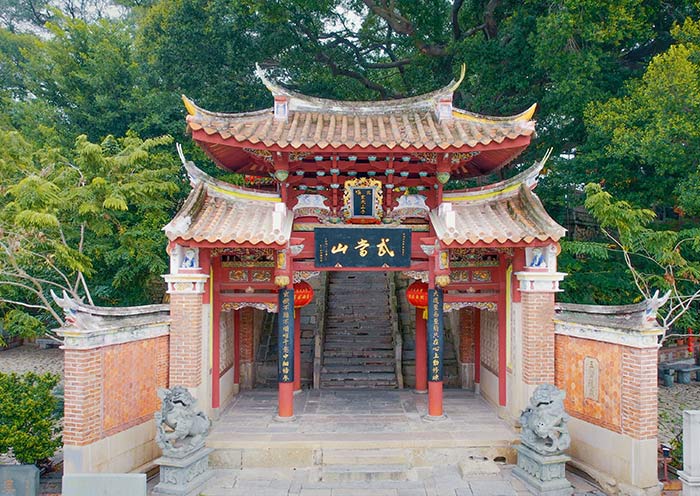
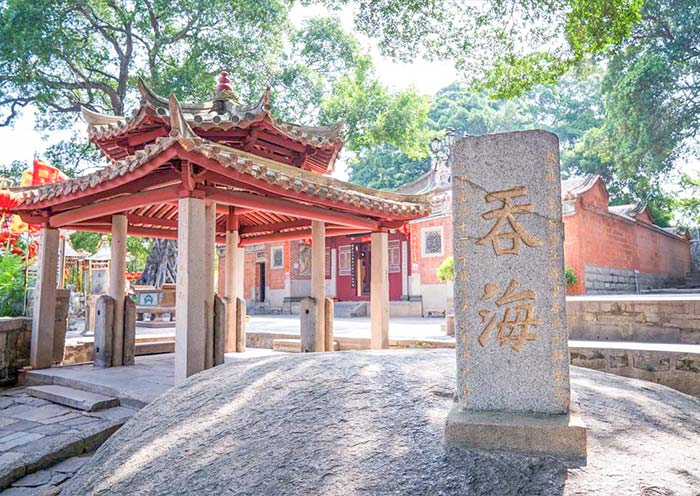
Best Things to Do in Quanzhou
In addition to being “an office where deities are established on earth” (神明在人间办事处), Quanzhou also boasts a long history of maritime trade and a rich cultural life.
No.8 Visiting Quanzhou Maritime Museum to Learn Long History of Maritime Trade
The Quanzhou Maritime Museum, also known as the Quanzhou Overseas Communication History Museum, is located in Fengze District, on the east side of Kaiyuan Temple. It consists of two exhibition areas: Kaiyuan Temple Museum and Donghu New Museum, showcasing the city's important role as a starting point of the ancient Maritime Silk Road.
The museum has seven sub-museums. Exhibits in the museum cover a wide range of topics related to maritime trade, including navigation technology, shipbuilding techniques, and cultural exchanges that occurred through sea routes.
The museum is also home to a shipwreck salvaged from the sea near Quanzhou, providing visitors with a glimpse into the city's maritime past.
No. 9 Strolling along the Characteristic Streets in Quanzhou
West Street (Xi Jie), Tumen Street, and Zhongshan Road are the most important and bustling streets in Quanzhou. They form a Z-shaped distribution centered around Zhongshan Road. You can spend a day exploring these streets and experiencing the rich cultural atmosphere of Quanzhou.
West Street: West Street is the oldest and yet the most youthful street in Quanzhou. In the Song Dynasty, West Street was a symbol of Quanzhou's prosperity. Today, it is a must-visit food street for visitors.
Tumen Street: Tumen Street has 13 Song and Yuan relics distributed on both sides. The aforementioned Confucius Temple, Qingjing Temple, and Guan Yue Temple are the three most famous ones.
Zhongshan Road: It is the only, longest, and best-preserved continuous arcade-style commercial street in China. Here, you can smell the ancient aroma in the air and feel the charm of the world heritage Quanzhou.


No.10 Explore the Xunpu Village to Experience Local life
Xunpu Village is located at the mouth of the Jinjiang River (晋江) entering the sea, about 10 kilometers from the old town of Quanzhou. It is an ancient fishing village with a long-standing heritage, featuring many unique and mysterious traditions. Among them, the most fascinating are the Zanhua Women and Oyster Shell Houses.
The "Zanhua Women" tradition refers to the custom of women in Xunpu Village wearing ornate hairpins (zanhua) in their hair. This custom is a symbol of the unique local culture and is related to the village's history of overseas trade.
Oyster Shell Houses are traditional houses in Xunpu Village built using oyster shells. The shells are mixed with sand and glutinous rice to form a strong, weather-resistant material. This unique construction method showcases the village's close relationship with the sea and is a reflection of the local cultural and architectural style.
How to Plan Your Quanzhou Trip & Extension to Fujian
With a day trip, travelers can get a glimpse of historical heritage and the scenic views Quanzhou has to offer, which would cover some of the top attractions including Kaiyuan Temple, Qingjing Mosque, Guanyue Temple, and Quanzhou Maritime Museum. If you would like a more immersive experience, a 2-day trip or more time is ideal for you to cover more tour spots in Quanzhou City.
If you're planning a trip to Quanzhou or any attractions in Fujian, it's highly recommended to start from Xiamen. If you have a bit more time, around 4-6 days, consider extending your trip to the neighboring attractions in Fujian province. This will allow you to delve deeper into the region and experience its diverse natural landscapes and rich cultural offerings. Don't miss the chance to visit Xiamen, Fuzhou, Hakka Tulou (another UNESCO World Heritage in Fujian), and Xiapu for a more immersive travel experience.


Explore Quanzhou/Fujian with Asia Odyssey Travel
Asia Odyssey Travel has a local office and a team of local experts in Quanzhou who can provide you with an in-depth insight into Quanzhou and its surrounding areas in Fujian province. Quanzhou, being one of the hottest tour destinations in China, has so many to offer for tourists. It is not a problem finding the attractions yet planning ahead, booking in advance and local guide could save you a considerable amount of time and energy.
We provide flexible Quanzhou tours that can be tailored to your specific needs, ensuring you make the most of your time during your brief visit. As Quanzhou is a popular tourist destination, it is advisable to book everything in advance. Plan ahead and contact us today to secure your arrangements.








